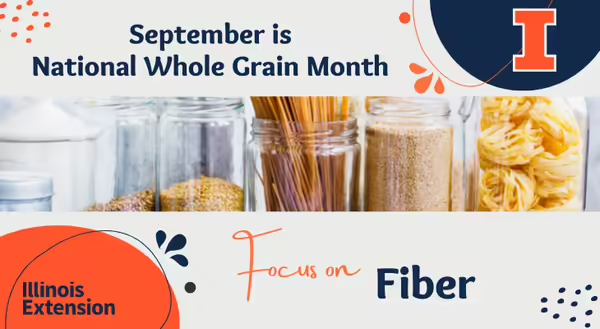
Whole grains are an essential part of a healthy and well-balanced diet. They provide fiber and vital nutrients our bodies need, such as B vitamins, antioxidants, and trace minerals like iron and zinc.
Dietary fiber is a form of carbohydrate that your body cannot absorb or digest. Because dietary fiber cannot be digested or broken down, it adds bulk to our stool, which helps you to stay regular and promotes a healthier gut microbiome. Those consuming a diet rich in fiber generally have a reduced overall calorie intake because many high-fiber foods are low in calories. Foods rich in fiber helps you feel fuller longer, eat less, and stay satisfied longer, which helps in weight management.
There are many additional health benefits to consuming fiber. For one, the body has to work harder to break down high-fiber foods. This slows the absorption of natural sugars within those foods, positively impacting blood sugars. It also helps lower total blood cholesterol levels by reducing our "bad" cholesterol, otherwise known as low-density lipoproteins or LDL-cholesterol.
With all we know about fiber and its health benefits, one would think everyone is consuming adequate amounts. However, on average, only 5% of Americans consume the recommended amount of fiber each day. The amount of dietary fiber needed each day will depend on our age and gender. Adults should consume at least:
- Men 51 years and older: 30 grams/day
- Men 50 years and younger: 38 grams/day
- Women 51 years and older: 25 grams/day
- Women 50 years and younger: 21 grams/day
The 2020 Dietary Guidelines recommend that all Americans make at least half their grains, whole grains, including older adults. Meaning, most people should consume three or more servings of whole grains each day.
All grains start as whole grains. However, many grains have vital nutrients stripped away during processing, making them less healthy. Therefore, when selecting grain-based foods, it is important to choose whole-grain foods. For an item to be considered a whole grain, all three components of the grain kernel must be included: bran, germ, and endosperm in their original proportions.
Finding whole-grain foods can be easy when they contain the Whole Grain Stamp. The stamp is a packaging label placed on products to help consumers easily identify products containing significant amounts of whole grain. The label features a sheaf of grain on a golden-yellow background with a bold black border. There are three different varieties of the Whole Grain Stamp, the 100% Stamp, the 50%+ Stamp, and the Basic Stamp. Each stamp tells you how many grams of whole grain are in one serving of the product.
Here are some easy and tasty ideas to help you focus on fiber this month by including more whole grains in your everyday meals.
- Look for the Whole Grain Stamp when shopping and purchase items high in fiber.
- Start your morning with old-fashioned oats (oatmeal) with fresh berries or cinnamon, or try whole-grain corn grits with eggs. Learn more about oats and its health benefits.
- For lunch, use a whole-grain pita and stuff it with hummus and veggies.
- Include whole grain snacks, such as whole-grain graham crackers, popcorn or whole-grain melba toast, or crackers with tuna or canned salmon.
- Serve black beans with brown rice or barley and veggies for dinner. Or try baked fish and veggies, served with farro or brown rice. You can also add whole grains like barley or bulgur to soups and stews.
Whether focusing on increasing your overall fiber intake in the coming month or embracing whole grains, remember portion sizes matter. When portioning out your favorite whole-grain foods, remember to look at the serving size, as this will help you better meet your wellness goals.
Source: Diane Reinhold, MPH, MS, RDN is a University of Illinois Extension, Educator, Nutrition and Wellness, serving Jo Daviess, Stephenson & Winnebago Counties
References:
MyPlate U.S. DEPARTMENT OF AGRICULTURE. (n.d.). Grains: What foods are in the Grains Group? MyPlate. https://www.myplate.gov/eat-healthy/grains.
U.S. Department of Agriculture and U.S. Department of Health and Human Services. Dietary Guidelines for Americans, 2020-2025. 9th Edition. December 2020. Available at DietaryGuidelines.gov.
What counts as a serving? What Counts as a Serving? | The Whole Grains Council. (n.d.). https://bit.ly/3jRwSv5
Whole grain stamp. Whole Grain Stamp | The Whole Grains Council. (n.d.). https://wholegrainscouncil.org/whole-grain-stamp.